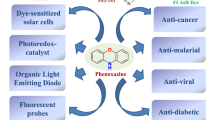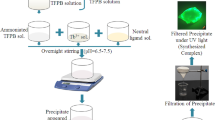Abstract
Two triphenylamine chalcone derivatives 1 and 2 were synthesized through the Vilsmeier-Haack reaction and Claisen-Schmidt condensation reaction. Through ultraviolet absorption spectroscopy and fluorescence emission spectroscopy experiments, it was confirmed that these two compounds exhibited good aggregation-induced emission (AIE) behavior in ethanol/water mixtures. The solvent effect test showed with the increase of the orientation polarizability of the solvent, the Stokes shift in the solvent of compound 1 and compound 2 shows a linear change trend. Through solid state fluorescence test and universal density function theory (DFT), the existence of π-π stacking interaction in the solid state of the compound has been studied, resulting in weak fluorescence emission. pH has no effect on the fluorescence intensity of the aggregate state of excited state intramolecular proton transfer (ESIPT) molecules in an acidic environment, but greatly weakens its fluorescence intensity in an alkaline environment. Cyclic voltammetry (CV) test shows that compound 1 was more prone to oxidation reaction than compound 2. The results of thermal stability test show that the thermal stability of compound 1 was better than that of compound 2, indicating that triphenylamine chalcone derivatives can improve the thermal stability of compounds by increasing the number of branches.











Similar content being viewed by others
Data Availability
The 1 H NMR, 13 C NMR HR-ESI-Ms of the 1 and 2 are detailed in the Supporting information. These materials are available free of charge via the Internet.
Code Availability
Not applicable.
References
Xie Z, Chen C, Xu S, Li J, Zhang Y, Liu S, Xu J, Chi Z (2015) White-light emission strategy of a single organic compound with aggregation‐induced emission and delayed fluorescence properties. Angew Chem Int Ed 127(24):7287–7290
Sun J, Lu Y, Wang L, Cheng D, Sun Y, Zeng X (2013) Fluorescence turn-on detection of DNA based on the aggregation-induced emission of conjugated poly (pyridinium salt) s. Polym Chem 4(14):4045–4051
Huang J, Jiang Y, Yang J, Tang R, Xie N, Li Q, Li Z (2014) Construction of efficient blue AIE emitters with triphenylamine and TPE moieties for non-doped OLEDs. J Mater Chem C 2(11):2028–2036
Liu M, Zhang X, Yang B, Liu L, Deng F, Zhang X, Wei Y (2014) Polylysine crosslinked AIE dye based fluorescent organic nanoparticles for biological imaging applications. Macromol Biosci 14(9):1260–1267
Jiang R, Cao M, Liu M, Liu L, Huang Q, Huang H, Wei Y (2018) AIE-active self-assemblies from a catalyst-free thiol-yne click reaction and their utilization for biological imaging. Mater Sci Eng C 92:61–68
Niu G, Zhang R, Shi X, Park H, Xie S, Kwok RT, Tang BZ (2020) AIE luminogens as fluorescent bioprobes. TrAC Trend Anal Chem 123:115769
Mohan M, James J, Satyanarayan MN, Trivedi DR (2019) Functionalized pyrene-based AIEgens: synthesis, photophysical characterization and density functional theory studies. Lumin 34:715–723
Yang W, Li C, Zhang M, Zhou W, Xue R, Liu H, Li Y (2016) Aggregation-induced emission and intermolecular charge transfer effect in triphenylamine fluorophores containing diphenylhydrazone structures. Phys Chem Chem Phys 18(40):28052–28060
Mathivanan M, Tharmalingam B, Lin CH, Pandiyan BV, Thiagarajan V, Murugesapandian B (2020) ESIPT-active multi-color aggregation-induced emission features of triphenylamine–salicylaldehyde-based unsymmetrical azine family. Cryst Eng Comm 22(2):213–228
Felouat A, Curtil M, Massue J, Ulrich G (2019) Excited-state intramolecular proton transfer (ESIPT) emitters based on a 2-(2′-hydroxybenzofuranyl) benzoxazole (HBBO) scaffold functionalised with oligo (ethylene glycol)(OEG) chains. New J Chem 43(23):9162–9169
Zhou J, Shi R, Liu J, Wang R, Xu Y, Qian X (2015) An ESIPT-based fluorescent probe for sensitive detection of hydrazine in aqueous solution. Org Biomol Chem 13(19):5344–5348
Li Y, Ma Y, Yang Y, Shi W, Lan R, Guo Q (2018) Effects of different substituents of methyl 5-R-salicylates on the excited state intramolecular proton transfer process. Chem Chem Phys 20(6):4208–4215
Zhang H, Qu Y, Gao Y, Hua J, Li J, Li B (2013) A red fluorescent ‘turn-on’chemosensor for Hg2+ based on triphenylamine–triazines derivatives with aggregation-induced emission characteristics. Tetrahedron Lett 54(8):909–912
Dumat B, Faurel-Paul E, Fornarelli P, Saettel N, Metgé G, Fiorini-Debuisschert C, Teulade-Fichou MP (2016) Influence of the oxazole ring connection on the fluorescence of oxazoyl-triphenylamine biphotonic DNA probes. Org Biomol Chem 14(1):358–370
Li Q, Wang Z, Song W, Ma H, Dong J, Quan YY, Huang ZS (2019) A novel D-π-A triphenylamine-based turn-on colorimetric and ratiometric fluorescence probe for cyanide detection. Dye Pigment 161:389–395
Yin J, Peng M, Ma Y, Guo R, Lin W (2018) Rational design of a lipid-droplet-polarity based fluorescent probe for potential cancer diagnosis. Chem Commun 54(85):12093–12096
Kong L, Yang J, Zhou H, Li S, Hao F, Zhang Q, Tian Y (2013) Synthesis, photophysical properties and TD-DFT calculation of four two-photon absorbing triphenylamine derivatives. Science China Chem 56(1):106–116
Wang Y, Yang C, Li B, Shi F, Gao Y, Wang Z, Peng H (2018) Solvent dependent ultrafast dynamics of multi-branched thiophene-based triphenylamine derivatives with a triazine core. Optik 167:80–87
Yang M, Xu D, Xi W, Wang L, Zheng J, Huang J, Tian Y (2013) Aggregation-induced fluorescence behavior of triphenylamine-based schiff bases: the combined effect of multiple forces. Org Chem 78(20):10344–10359
Zhang M, Yang W, Gong T, Zhou W, Xue R (2017) Tunable AIEE fluorescence constructed from a triphenylamine luminogen containing quinoline–application in a reversible and tunable pH sensor. Phys Chem Chem Phys 19(32):21672–21682
Usuki T, Shimada M, Yamanoi Y, Ohto T, Tada H, Kasai H, Nishihara H (2018) Aggregation-induced emission enhancement from disilane-bridged donor–acceptor–donor luminogens based on the triarylamine functionality. ACS Appl Mater Interfaces 10(15):12164–12172
Niu G, Zheng X, Zhao Z, Zhang H, Wang J, He X, Tang BZ (2019) AIE-Active Functionalized acrylonitriles with aggregation-induced emission: structure tuning by simple reaction-condition variation, efficient red emission, and two-photon bioimaging. J Am Chem Soc 141(38):15111–15120
Wang X, Ding G, Duan Y, Zhu Y, Zhu G, Wang M, Li X, Zhang Y, Qin X, Hung CH (2020) A novel triphenylamine-based bis-Schiff bases fluorophores with AIE-Activity as the hydrazine fluorescence turn-off probes and cell imaging in live cells. Talanta 217:121029
Cheng Hr, Ji Y, Liu F, Lu Xj (2019) Rapid and visual detection for hypochlorite of an AIE enhanced fluorescence probe. Lumin 34:903
Satam MA, Telore RD, Sekar N (2014) Photophysical properties of Schiff’s bases from 3-(1, 3-benzothiazol-2-yl)-2-hydroxy naphthalene-1-carbaldehyde. Spectrochimica Acta Part a-Molecular Biomolecular Spectroscopy 132:678–686
Matsumoto H, Ikedu S, Tosaka T, Nishimura Y, Arai T (2018) Kinetic analysis of tautomer forms of aromatic-urea compounds with acetate ions: solvent effect of excited state intermolecular proton transfer. Photochem Photobiol Sci 17:561–569
Chen Y, Yang Y, Zhao Y, Liu S, Li Y (2019) Effect of solvent environment on excited state intramolecular proton transfer in 2-(4-(dimethylamino) phenyl)-3-hydroxy-6,7-dimethoxy-4 h-chromen-4-one. PhysChem Chem Phys 21(32):17711–17719
Qi Y, Lu M, Wang Y, Tang Z, Gao Z, Tian J, Liu J (2019) A theoretical study of the ESIPT mechanism of 3-hydroxyflavone derivatives: solvation effect and the importance of TICT for its dual fluorescence properties. Org Chem Front 6(17):3136–3143
Ding S, Xu A, Sun A, Xia Y, Liu Y (2021) Substituent effect on ESIPT and hydrogen bond mechanism of N-(8-Quinolyl) salicylaldimine: A detailed theoretical exploration. Spectrochim Acta Part A Mol Biomol Spectrosc 245:118937
Ni M, Su S, Fang H (2020) Substituent control of photophysical properties for excited-state intramolecular proton transfer (ESIPT) of o-LHBDI derivatives: a TD-DFT investigation. J Mol Model 26(5):1–10
Chrayteh A, Ewels C, Jacquemin D (2020) Dual fluorescence in strap ESIPT systems: a theoretical study. Phys Chem Chem Phys 22(2):854–863
Zhang N, Liu G, Yan J, Zhang T, Liu X (2020) Naked diazaborepin dyes: Synthesis, photophysical properties, substituent effects and theoretical calculations on ESIPT process. Dye Pigment 175:108218
Yan L, Qing T, Li R, Wang Z, Qi Z (2016) Synthesis and optical properties of aggregation-induced emission (AIE) molecules based on the ESIPT mechanism as pH- and Zn2+-responsive fluorescent sensors. RSC Adv 6(68):63874
Zhu H, Huang J, Kong L, Tian Y, Yang J (2018) Branched triphenylamine luminophores: aggregation-induced fluorescence emission, and tunable near-infrared solid-state fluorescence characteristics via external mechanical stimuli. Dye Pigment 151:140–148
Jin H, Li X, Tan T, Wang S, Xiao Y, Tian J (2014) Electrochromic properties of novel chalcones containing triphenylamine moiety. Dye Pigment 106:154–160
Bozkurt E, Gul HI, Mete E (2018) Solvent and substituent effect on the photophysical properties of pyrazoline derivatives: A spectroscopic study. J Photochem Photobiol A chem 352:35–42
Satam MA, Telore RD, Tathe AB, Gupta VD, Sekar N (2014) A combined theoretical and experimental investigation on the solvatochromism of ESIPT3-(1, 3-benzothiazol-2-yl)-2-hydroxynaphthalene-1-carbaldehyde. Spectrochim Acta Part A Mol Biomol Spectrosc 127:16–24
Feng Q, Li Y, Li K, Lu J, Wang J, Fan P, Hou H (2017) Fluorescent chemosensor for zinc ion detection with significant emission color change in aqueous solution based on AIEgen. ChemistrySelect 2(10):3158–3162
Fang H, Wang N, Xie L, Huang P, Deng KY, Wu FY (2019) An excited-state intramolecular proton transfer (ESIPT)-based aggregation-induced emission active probe and its Cu (II) complex for fluorescence detection of cysteine. Sens Actuator B-Chem 294:69–77
Liang C, Jiang S (2017) Fluorescence light-up detection of cyanide in water based on cyclization reaction followed by ESIPT and AIEE. Analyst 142(24):4825–4833
Sharma S, Virk TS, Pradeep CP, Dhir A (2017) ESIPT-induced carbazole‐based AIEE material for nanomolar detection of Cu2+ and CN– Ions: a molecular keypad security device. Eur J Inorg Chem 18:2457–2463
Li R, Yan L, Wang Z, Qi Z (2017) An aggregation-induced emissive NIR luminescent based on ESIPT and TICT mechanisms and its application to the detection of Cys. J Mol Struct 1136:1–6
Chen G, Wang HY, Liu Y, Xu XP, Ji SJ (2010) The synthesis and characterisation of novel pyrazoline derivatives containing triphenylamine. Dye Pigment 85(3):194–200
Revoju S, Biswas S, Eliasson B, Sharma GD (2018) Asymmetric triphenylamine–phenothiazine based small molecules with varying terminal acceptors for solution processed bulk-heterojunction organic solar cells. Phys Chem Chem Phys 20(9):6390–6400
Author information
Authors and Affiliations
Contributions
Ying-Peng Zhang, contributed to the conception of the study;
Qi Teng, performed the experiment and wrote the manuscript;
Yun-Shang Yang, contributed significantly to analysis and manuscript preparation;
Jing-Qi Cao, performed the data analyses;
Ji-Jun Xue, helped perform the analysis with constructive discussions.
Corresponding author
Ethics declarations
Conflict of Interest
The authors declare that they have no conflict of interest.
Additional information
Publisher’s Note
Springer Nature remains neutral with regard to jurisdictional claims in published maps and institutional affiliations.
Supplementary Information
ESM 1
(DOC 13157 kb)
Rights and permissions
About this article
Cite this article
Zhang, YP., Teng, Q., Yang, YS. et al. Aggregation‐induced Emission Properties of Triphenylamine Chalcone Compounds. J Fluoresc 31, 807–815 (2021). https://doi.org/10.1007/s10895-021-02711-6
Received:
Accepted:
Published:
Issue Date:
DOI: https://doi.org/10.1007/s10895-021-02711-6




